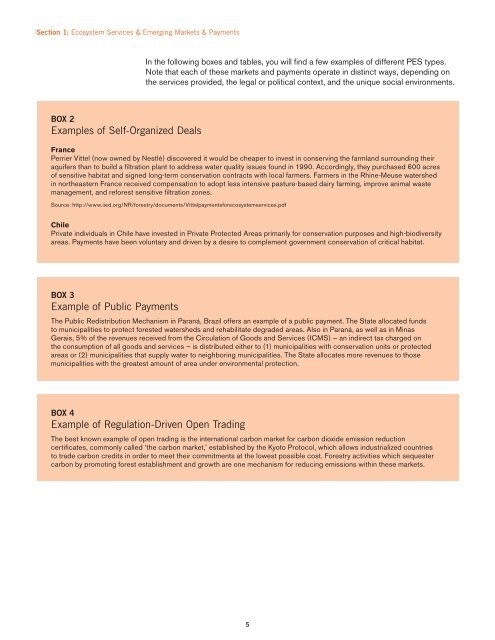Payments for Ecosystem Services: Getting Started. A Primer - UNEP
Payments for Ecosystem Services: Getting Started. A Primer - UNEP
Payments for Ecosystem Services: Getting Started. A Primer - UNEP
You also want an ePaper? Increase the reach of your titles
YUMPU automatically turns print PDFs into web optimized ePapers that Google loves.
Section 1: <strong>Ecosystem</strong> <strong>Services</strong> & Emerging Markets & <strong>Payments</strong><br />
In the following boxes and tables, you will fi nd a few examples of different PES types.<br />
Note that each of these markets and payments operate in distinct ways, depending on<br />
the services provided, the legal or political context, and the unique social environments.<br />
BOX 2<br />
Examples of Self-Organized Deals<br />
France<br />
Perrier Vittel (now owned by Nestlé) discovered it would be cheaper to invest in conserving the farmland surrounding their<br />
aquifers than to build a fi ltration plant to address water quality issues found in 1990. Accordingly, they purchased 600 acres<br />
of sensitive habitat and signed long-term conservation contracts with local farmers. Farmers in the Rhine-Meuse watershed<br />
in northeastern France received compensation to adopt less intensive pasture-based dairy farming, improve animal waste<br />
management, and re<strong>for</strong>est sensitive fi ltration zones.<br />
Source: http://www.iied.org/NR/<strong>for</strong>estry/documents/Vittelpayments<strong>for</strong>ecosystemservices.pdf<br />
Chile<br />
Private individuals in Chile have invested in Private Protected Areas primarily <strong>for</strong> conservation purposes and high-biodiversity<br />
areas. <strong>Payments</strong> have been voluntary and driven by a desire to complement government conservation of critical habitat.<br />
BOX 3<br />
Example of Public <strong>Payments</strong><br />
The Public Redistribution Mechanism in Paraná, Brazil offers an example of a public payment. The State allocated funds<br />
to municipalities to protect <strong>for</strong>ested watersheds and rehabilitate degraded areas. Also in Paraná, as well as in Minas<br />
Gerais, 5% of the revenues received from the Circulation of Goods and <strong>Services</strong> (ICMS) — an indirect tax charged on<br />
the consumption of all goods and services — is distributed either to (1) municipalities with conservation units or protected<br />
areas or (2) municipalities that supply water to neighboring municipalities. The State allocates more revenues to those<br />
municipalities with the greatest amount of area under environmental protection.<br />
BOX 4<br />
Example of Regulation-Driven Open Trading<br />
The best known example of open trading is the international carbon market <strong>for</strong> carbon dioxide emission reduction<br />
certifi cates, commonly called ‘the carbon market,’ established by the Kyoto Protocol, which allows industrialized countries<br />
to trade carbon credits in order to meet their commitments at the lowest possible cost. Forestry activities which sequester<br />
carbon by promoting <strong>for</strong>est establishment and growth are one mechanism <strong>for</strong> reducing emissions within these markets.<br />
5
















